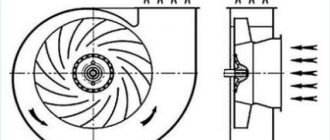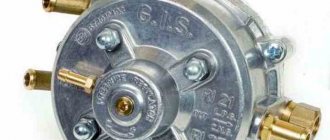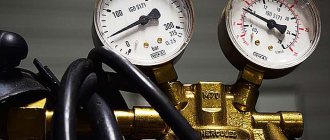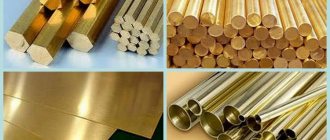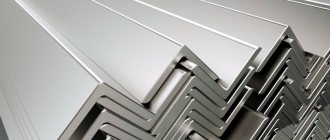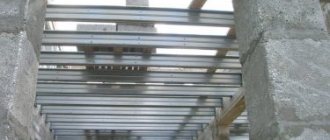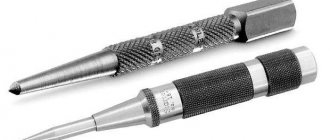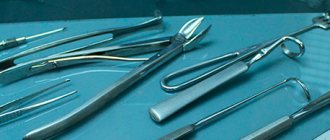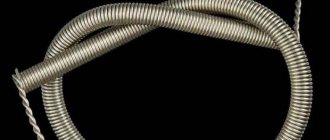Topographic curvimeter: main task and design
Curvimeter (curvus - from Latin) is a device with which distances are measured on topographic material (map, diagram, plan) with a minimum error. Construction institutes, as well as travelers, climbers, hunters and many other specialists and professionals who to this day prefer a paper map to an electronic medium know about the curvimeter, what it is and its photo.
The device measures curves, which is necessary when mapping routes. The principle of operation of a curvimeter is only one: holding the device along a winding line to measure its length. The resulting value is converted into distance units, taking into account the topographic scale.
Since the discovery of the mechanical curvimeter by the Germans, about 150 years ago, the mechanism and design have remained virtually the same:
- A case with a scale (dial) of a rectilinear or circular type. In different models, either the dial or the hand is movable.
- The wheel is small in size with serrations (teeth).
- Handle (holder).
Let's take a look at the mechanical curvimeter, what it is - the photo looks like this:
The scale is in centimeters or inches, the standard value is 100 cm in 1 cm increments, and the possible error is 0.25 cm per 50 cm of length. To reset the result obtained on the dial, a modern model of a mechanical device has a button to return to zero; otherwise, you need to spin the wheel in the opposite direction.
Types of curvimeters for maps
Curvimeter for cards is:
- Mechanical.
- Electronic.
They differ in cost and ease of use. Mechanical ones are more reliable and trouble-free, while electronic ones are easiest to use.
Mechanical
The most common and inexpensive. They are highly reliable and durable. Typically, the length that the device can measure in one pass is 100 cm. The error of mechanical models is 0.5%. Also, the level of error depends on the correct use of the tool. If the wheel does not rotate evenly, the error will increase. The curvimeter is equipped with a cover or case to protect it from mechanical damage.
The arrow of mechanical curvimeters for maps moves in a circle, like in a watch. It is connected to a wheel. The scale it points to may have several markings. The simplest devices simply convert the number of revolutions of the wheel when rolling along the road line on the map into centimeters. More advanced instruments make it possible to obtain data not in centimeters, which will later have to be converted into kilometers taking into account the scale, but immediately in kilometers.
In the event that you are using a simple device that measures wheel revolutions in centimeters, you need to set its arrow to the reference point in the “0” position and begin to follow the road line on the map. The device must be pressed tightly so that every millimeter of the measurement line rotates the wheel. Having reached the end point, the device is removed from the paper surface to prevent further rotation of the wheel. The resulting length in centimeters is multiplied by the map scale. If its scale is 1:50000, then this means that 1 cm measured using a curvimeter is equal to 500 m on a real landscape. Thus, if using the device when measuring the length of the route, 20 cm was obtained on the map, then on the real road it is 10 km.
Electronic curvimeter
Electronic curvimeters are more advanced and accurate. Their error is only 0.2%. Such devices are equipped with an LCD display and setting buttons. You can initially enter the map scale, and then work with the device, just like a mechanical one. The length of the route in kilometers will be displayed on the device screen. The device will independently multiply the length indicator obtained on the map by its scale.
Often, electronic devices, in addition to their intended purpose, also perform other functions. Some manufacturers combine them with a compass, and can also install an LED flashlight in their housing. At the same time, the power supply of the LED and LCD display is common, so if there is a lot of light, the device will stop working and the batteries will need to be replaced.
Electronic devices are often made in the form of a ballpoint pen. They have an elongated shape, which makes them easier to wear. The impeller is hidden using a cap. To work, simply remove the cap and take measurements. It is also worth noting that the shape of the pen is much more convenient for tracing a line on a map than a device with a round dial.
To retrieve data from hard-to-use graphics cards and perform complex calculations, some electronic models are equipped with their own memory and specialized software. They are connected to a computer, which allows you to download the received data for further processing. Such devices are used by architects when working with drawings, as well as for copying and studying historical maps.
Rules for using the curvimeter
There are three basic rules for using the device in practice to achieve the most accurate result:
- The entire length that needs to be measured is divided into separate sections with bookmarks between them.
- The use of topographic material with a large scale - 1:50,000, 1: 100,000. In this case, careful repetition of the bends of the line, the length of which is measured, is mandatory.
- The “measure seven times” rule. The obtained result must be checked, preferably more than once - this makes it possible to eliminate errors by checking the values of several measurements with each other.
How to improve measurement accuracy
To obtain maximum measurement accuracy, you need to use maps with a large scale. The higher it is, the smaller the error. Maps with a scale of 1:50000 and 1:100000 will be optimal.
The main rule that should be followed when using a curvimeter is that the measurement must be carried out several times. Often, the routes measured using a curvimeter have many curls that are difficult to navigate even with the small wheel of the device. In this regard, small errors occur, which in total will give a rather large deviation. In this regard, it is necessary to carry out measurements at least several times. It is advisable to first measure the distance between points in one direction, and then in the opposite direction. The resulting data may vary. If this happens, then you should derive the arithmetic average by adding all the indicators together and dividing them by the number of measurements. The data obtained as a result of this calculation will be more accurate.
Types of devices, their advantages
Beyond the specified criterion, the device can be mechanical, as mentioned above, or electronic.
A mechanical device is more convenient in field conditions, as it is accurate, compact and unpretentious. The differences between different manufacturers and years of production include:
- device form;
- scale type;
- units of measurement;
- availability of additional functions.
Advantages of a mechanical device:
- dust, water, temperature and shock resistance of the mechanism;
- weight approximately 50-100 g, size – no more than the palm of your hand;
- does not need recharging.
The electronic type is more suitable for working with cartography indoors at a table, as it is more “sensitive” to surface irregularities.
Video: How to make the device yourself
Advantages of the electronic analogue:
- compact size (similar to a keychain, ballpoint pen), light weight (up to 50 g);
- continuous operation of the device – up to 400 hours;
- has a compass, calculator and flashlight;
- ability to change units of measurement;
- performs ready-made calculations - the scale is set in the device;
- data saving function.
Which curvimeter to choose?
The choice of a curvimeter is based on the tasks that it must solve, and therefore, first of all, on its accuracy.
So, to plot a route long before the start of a tourist trip, it is better to purchase an electronic tool.
Due to the minimal error, it allows you to measure distances quite accurately on small-scale maps.
On a hike, it is preferable to take the mechanical version because of its high reliability and independence from power sources.
For artistic forging, when you need to measure the length of workpieces according to drawn patterns, any, even the most inexpensive, cartographic curvimeter will do, since the size of the error plays virtually no role here.
Road curvimeter
Let's look at a road curvimeter and what it is (photo below) - a type of device adapted for measuring distances on terrain with almost any, even uneven, surface. Its help is most often resorted to when there is no opportunity and conditions to use a tape measure, light range finder or other measuring device.
The device is also called a road wheel, the dimensions of which are quite impressive and the weight is approximately 2 kg. Outwardly it looks like an educational toy for little ones, the principle of which is that the wheel moves forward with the help of a handle.
All road curvimeters differ from each other for:
- size and weight;
- wheel type: disc (solid) or with spokes;
- measurement range and step;
- fastening the meter: attached to the handle or attached to the wheel;
- measurement method: electronic or mechanical.
The device consists of the following parts:
- wheel;
- folding handle;
- counter;
- brake button;
- functional buttons and display – in electronic version.
Device and characteristics
Despite the number of types of curvimeters, its main elements remain unchanged.
The design consists of a body on which there is a scale.
Some models are equipped with a handle for ease of use, while others have a ring installed in this place, allowing you to attach the device with a chain to a pocket or other item of clothing.
Moreover, different versions have a digital display instead of a classic dial.
On the reverse side there is a stand (leg) with a working element in the form of a gear wheel.
In fact, the basis of the work is the conversion of the number of revolutions of the latter into the length of the measured segment.
The device described above is, by and large, valid for curvimeters used on the ground, with the exception of a completely different shape and size.
Material
Classic curvimeters, designed for measuring segments on paper, are very similar in appearance to pocket watches.
As a rule, this is a metal case, where the dial and hand are covered with durable shock-resistant glass.
The housing of the electronic options, which display measurement results on a liquid crystal screen, is made of impact-resistant plastic.
The wheel itself is also made of metal or plastic.
Curvimeters for field work are equipped with a large-diameter wheel made of metal or impact-resistant plastic with a rubber-coated rim.
For ease of operation, the plastic handle with controls is usually located on an aluminum stand, which significantly lightens the weight of the tool.
Externally, such a device looks like the front fork of a bicycle, where instead of a steering wheel there is a handle for gripping with one hand.
Dimensions and weight of curvimeters
The dimensions of a cartographic curvimeter are comparable to a pocket watch or a stopwatch.
So its length on average is about 10 cm, and the diameter of the part of the case with the dial is about 5 cm.
Such a device weighs 30–50 g.
For electronic models, depending on the manufacturer, the dimensions and weight may vary significantly.
The dimensions of the instrument are also influenced by the design of the case and the presence of various additional functions, in fact, like mechanical models.
On average, its length is about 15 cm.
The road curvimeter is equipped with a wheel, the diameter of which can vary widely, in accordance with the developed model.
As a rule, on average this figure is 150 – 400 mm.
A similar tool weighs 2–4 kg.
Metric system and uncertainty
When taking measurements on a map with a certain scale, curvimeters with a metric dial are usually used.
Mechanical models, in most cases, have two dials (one on opposite sides of the case).
At the same time, some scales reflect the directly traveled path of the wheel in centimeters or inches, while others indicate the distance (taking into account the scale) on the ground in kilometers.
A scale marked in centimeters is much better suited for determining distances in kilometers due to the direct relationship 1 km = 100,000 cm.
That is, simple calculations can be easily done in your head with a known map scale.
So, for example, if the scale is 1:100,000, then 1 cm on the map equals 1 km on the ground.
With inches, such calculations cannot be done with the same ease, since 1 kilometer contains 39370.1 of them.
At the same time, the error of dial versions is, as a rule, 0.5% (5 meters per kilometer of distance on the scale indicated above), while for electronic models the error may not exceed 0.2%.
Additional functions
For ease of use and expanding the capabilities of the curvimeter, manufacturers equip the device with various additional functions.
Thus, mechanical models are often combined in one case with the same mechanical watch or compass.
For electronic models, this list is much expanded, since they are powered by batteries.
Such a tool is often equipped with:
- An additional display that displays the already calculated length taking into account the scale, volumes, areas and other useful information. The timer, current time, etc. can also be displayed here.
- Illuminated controls and work area for easy setup in low light conditions.
- Flashlight - a function that is never superfluous.
- A calculator is convenient for complex calculations of the same volume, area and distances on the ground.
In addition to everything, modern models have received the function of synchronizing with a computer via various interfaces, such as USB
, which allows you to transfer data to a PC, use it to build spreadsheets and in evaluation programs.
Working principle and main functions of a road wheel
The principle of operation is no different from the “desktop” one - you need to roll the device along a section of the road to measure it, and then take the readings from the display. The curvimeter can move forward and backward. In functional terms, it is possible to retain, save and delete data. Comes with a carrying case for convenient storage and transportation.
When working with it, it is also worth considering:
- When calculating the length of the route, it is better to break the line into several parts with memorable landmarks and points between them. The device is large and inconvenient to use for too long; it is worth taking into account the human factor when measuring a route, which can negatively affect the result.
- The larger and more detailed the map, the more accurate and convenient the measurement process and the quality of the task will be.
- Again, like the 3rd rule of using a curvimeter for maps, you will have to measure seven times here too. Given the complexity of the task due to the size and weight of the device, the responsible approach to the work being done would be to repeat the measurements at least one more time.
- To control your own location on the route, it is convenient to use points such as a checkpoint, a bridge over a river, a dam, etc. This is necessary in the event that the electronics fail, and along with it, communication with the outside world and place is lost finding.
- Keeping records of measurements, where individual points and distances are marked, is convenient if it is necessary to coordinate the route and compare it with the measurements of other group members.
In conclusion, I would like to note that the curvimeter is a convenient, popular device in its specificity, which clearly demonstrates the well-known fact that everything ingenious is simple.
Popular curvimeter models
Let's figure out which model of curvimeter for cards is better to buy. Let's look at the most popular options and reviews of them from real users.
Curvimeter of the Zlatoust watch factory KU-AM
Back in 1975, this model was awarded a quality mark. And you probably know that in those years they took this very seriously. So the curvimeter from the KU-AM plant is a classic.
Compass LX-1M with curvimeter
A miracle of Chinese manufacturers, in which, in addition to a compass, there may also be a thermometer for measuring air temperature. Like most Chinese “3 in 1” products, only one of the built-in devices works - and this is the curvimeter. You can buy this hand-held device through Yandex.Market or in a well-known Chinese online store.
How to use a curvimeter?
To measure distances between two points, say, on a map, the curvimeter scale is reset to zero, after which the device is installed with a wheel at one of the points and rolled to the second point without lifting and as accurately as possible along the line that needs to be measured.
A road wheel has the same principle of operation, with the only difference being that it must be rolled without lifting off the surface of the earth in front of you.
To do this, the counter readings are still reset to zero, and the handle is extended to approximately waist level.
The best electronic curvimeters
RGK Q159
The curvimeter of this model has an electronic counting mechanism, which ensures high measurement accuracy. The device has a wheel with a diameter of 159 mm, which provides good grip on different types of surfaces. The measuring wheel allows you to measure the distance of the road, mark the site, and determine the perimeter of the land plot.
Price - 3700 rub.
RGK Q159
Advantages:
- ease of use;
- convenient transportation;
- the rod is made of aluminum, telescopic, folding;
- presence of a display and control panel on the top;
- the device is equipped with built-in memory;
- you can select units of measurement;
- battery powered, two batteries are included with purchase;
- the function of saving results is active;
- tires are made of durable rubber;
- the presence of a folding footrest.
Flaws:
- No.
RGK Q318
A measuring wheel with an electronic type counting mechanism, thanks to which you can measure distances up to 10 km with maximum accuracy.
The wheel diameter is 318 mm, so the curvimeter has a reliable degree of adhesion to different surfaces, be it asphalt or a dirt road. The device is suitable for measuring distances during road or construction work, and is also easy to use in places where boundaries have complex shapes.
Price – 4900 rub.
RGK Q318
Advantages:
- high accuracy;
- small degree of error;
- can be used on various surfaces;
- the wheel is mounted on an axle with bearings;
- the device records the revolutions and their number;
- the wheel tire is made of polyurethane;
- the device measures distance even on damaged surfaces (pits, cracks);
- easy move;
- ease of use;
- convenient transportation;
- telescopic handle;
- The device is compact when folded and does not take up much space;
- equipped with a display and backlight;
- power source - batteries;
- there is a data saving function;
- the presence of a folding footrest.
Flaws:
- not detected.
RGK Q64
This curvimeter model is equipped with a high-precision counting mechanism, thanks to which you can measure arcs and lines. The measuring wheel is suitable for both construction and road work. Allows you to measure areas and determine the perimeter of areas. The model is distinguished by high quality and reliability in operation.
Price - 9900 rub.
RGK Q64
Advantages:
- suitable for various surfaces;
- the device wheel is mounted on an axle using ball bearings;
- easy rotation;
- polyurethane tire;
- excellent grip on surfaces;
- slight vibration of the device in active mode;
- ease of use;
- convenient transportation;
- folding handle;
- presence of a footrest;
- convenient taking of measurements;
- liquid crystal display;
- there is LED backlight;
- you can choose the units of measurement for indicators;
- the presence of a removable battery;
- There is an automatic shut-off function.
Flaws:
- No.
RGK Q159 775380
The device is equipped with an electronic mechanism for reading indicators, thanks to which high measurement accuracy is achieved with a small percentage of error.
The curvimeter has a wheel with a diameter of 159 mm and has reliable grip on different types of surfaces (paving stones, dirt road or asphalt road).
Using the device, you can find out the length of the road, mark the site, and calculate the perimeter of the land plot.
Price – 3700 rub.
RGK Q159 775380
Advantages:
- affordable price;
- telescopic rod made of aluminum;
- there are control buttons on the handle;
- presence of a display;
- folding design;
- you can adjust the height of the handle;
- easy to transport;
- built-in memory.
Flaws:
- not detected.
NEDO Deluxe 703111
The road wheel of this model is suitable for measuring distances where it is impossible to use other measuring instruments, for example, a tape measure. The device allows you to obtain accurate measurement data, with the smallest percentage of error.
Price - 13900 rub.
Country of origin: Germany
NEDO Deluxe 703111
Advantages:
- good measurement accuracy;
- easy move;
- slight vibration;
- convenient to store and transport;
- use on different surfaces;
- polyurethane wheel;
- ergonomic handle.
Flaws:
- high price.
NEDO 703113 (500 deluxe) 160 mm
This model is a compact measuring wheel, with high accuracy of measuring distances on different surfaces with a measurement limit of 9999.9 m.
Price – 12500 rub.
Country of origin: Germany
NEDO 703113 (500 deluxe) 160 mm
Advantages:
- build quality;
- small weight and size of the device;
- there is a brake;
- high accuracy of readings;
- data saving function;
- you can reset previously obtained calculations;
- ease of use.
- ergonomic telescopic handle;
- polyurethane tire;
- low vibration in active mode.
Flaws:
- high price.
Purpose of the device
The word curvimeter in Latin means curved. This simple device is designed for measuring distances on topographic maps when the segment has a curved, winding structure. This device was invented by the famous scientist M. Lomonosov to accurately measure curved lines in schematic images and is perfect for:
- atlas;
- cards;
- plan.
The device is also used directly on the ground during road work. The curve always bends in nature and on topographic maps. A curvimeter helps to perfectly measure such distances. The device comes to the aid of many people in everyday life and at work.
Types of curvimeters for terrain
The road wheel is used for almost all types of repair work on the road or when laying communications. The device is able to determine the distance between selected places with an accuracy of a tenth of a centimeter. The device is easy to use; all that is required of the user is to adjust the height to suit his height and walk in the chosen direction. The product will show the length of the surface and detect every pothole and hole, which is very important during construction. The counter is installed in two places: at the top, right next to the handle, or at the bottom, next to the wheel.
There are two types of devices in stores:
- Using a mechanical counter;
- With electronic element.
Mechanical
This option consists of rounded cylinders, along their periphery are numbers from 0 to 9. This design is similar to the one installed in a car to display the distance traveled. There is a special button on the side; by clicking on it, a person will quickly reset the information. Early readings are instantly erased and zero marks appear.
Previously, models were produced that were capable of operating at a distance of up to 1 km, which is why the readings had to be constantly recorded so as not to lose count. Since the product only displays meters, the numbers were updated when the value reached 999. Therefore, for long-distance measurements, they always took a piece of paper and a pen, or simply bought a more advanced model that could record up to 10 km.
When a person takes measurements on a flat surface, it is necessary to select a product that has a large wheel diameter. This is more practical because, due to the length, the device rolls faster and the hand gets less tired. The diameter of such a wheel is 31.847 cm. Therefore, as soon as the wheel makes a full revolution, one meter is counted. This design is convenient to use, since if the counter breaks down, the user can continue working, counting the values in his head.
Electronic
The equipment is equipped with an electronic counter and a convenient display that more accurately displays information on the screen. The only drawback of the model is its dependence on batteries; without their power, the device simply will not be able to function. When you plan to take measurements in the field, it is better to give preference to the mechanical option, or stock up on batteries, otherwise the meters traveled will not yield results. The advantage of such models is that they have built-in memory. In addition, the user can switch from miles to metric units of measurement or vice versa. Also, some devices can independently calculate the area of the measured area.
Regardless of the model chosen, the devices have the same body, which can be easily folded for maximum comfort during transportation. The height is adjusted individually for each worker. The actual wheel diameter varies, some may have a high diameter and others may not. It is important to remember that the smaller the wheel, the easier it is to transport the curvimeter.
The most important thing to consider when choosing is what terrain the device will be used on, since the size of the road wheel and the availability of special capabilities depend on this. In addition, this will determine what kind of surface will be installed: smooth, which is designed for asphalt roads, or studded, to provide maximum comfort on unpaved or slippery terrain.
What are curvimeters used for?
Curvimeters can be used for various purposes. However, here are the most ways to use this mechanism:
- carrying out construction work. For example, you need to measure the length and width of the site when building a house;
- road repair work. In this case, before starting cosmetic or complete road repairs, you should measure the distance of this road (in order to subsequently calculate the amount of necessary materials);
- measurements when painting curbs or other obstructed areas. For example, the length of a fence or stretched wire can be measured;
- geodetic measurements. In this case, curvimeters are needed to measure land areas. For example, the mechanism can replace the length of an arable land or a forest belt;
- measurements during land surveying. Curvimeters are used by special services that officially register areas.
Road curvimeters are designed specifically for measuring the duration of the road
Principle of operation
It is impossible to do without a curvimeter when measuring curved lines on the ground and in areas with curved relief, or on a topographic map. At the very beginning of the invention, such a specific device was designed quite simply. It had a toothed roller that was held on a handle, and the device also included a housing with a dial or scale and an index hand . The wheel follows the path of the curve as accurately as possible, and the scale counts the distance traveled. To calculate, you need to move the wheel as accurately as possible along the desired line to obtain the data. They are then multiplied by the scale in the diagram to obtain the actual distance.
Over time, the curvimeter became more modern as the scope of its use began to expand. They began to produce it with a more accurate electronic display scale.
Despite the improvement of the device, the principle of its operation remains unchanged: to measure distance, you need to walk the wheel along a curved line. The wheel gives readings on the dial scale. The length can be calculated by converting the distance into the required units of measurement, taking into account the specified scale. In an electronic device, the distance can be seen immediately. Such a curvimeter automatically shows the result in different units of measurement, including:
- meters;
- kilometers;
- miles;
- inches.
Mechanical instruments are not very accurate and their error is about 0.5%. However, such a model can easily cope with work where special accuracy is not needed. Curvimeters are still used in practice to calculate distances, since rulers or tape measures cannot show such fast and accurate results.
What to look for when choosing a curvimeter: tips and tricks
When choosing a curvimeter model, you should pay attention to some nuances:
- Before purchasing, you should decide on the type of device: mechanical or electronic. The choice of one model or another depends on the purpose of using the mechanism;
- One of the most important parameters that you should pay attention to when purchasing is the maximum measurement limit. For domestic use, you can purchase models with a limit of 1 kilometer, however, for more professional use, preference should be given to a model with a rating of at least 10 km;
- Another important nuance is the presence of a memory function in the curvimeter. This is very important if you need to save the results;
- Before making your final purchase, we recommend that you carefully inspect the model for any visible damage. If there are scratches or abrasions on the mechanism, it is better to purchase some other device.
